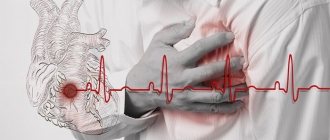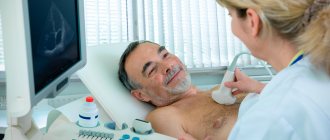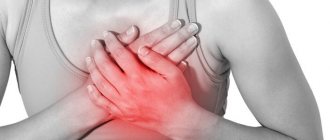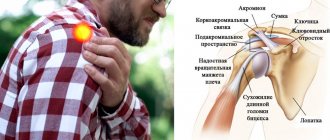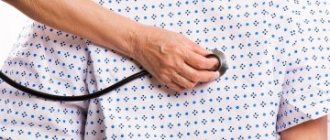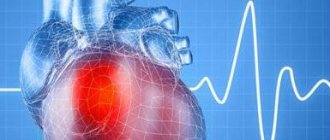At risk
- Patients with acute myocardial infarction, especially in the first hour of the development of a heart attack (it should be noted that sudden death that occurs in the early (acute) phase of myocardial infarction, verified clinically or at autopsy, is regarded as “death from a heart attack.” However, according to its mechanisms , clinical picture and complex of necessary resuscitation measures, it fully corresponds to sudden cardiac death that develops in other forms of coronary heart disease, and is therefore discussed in this section).
- Patients with heart failure
- Patients with a history of myocardial infarction, especially those with cardiomegaly and congestive heart failure
- Patients with coronary heart disease with high grade ventricular arrhythmias
- Patients with coronary heart disease who have several main risk factors: arterial hypertension, left atrial hypertrophy, smoking, disorders of carbohydrate and fat metabolism, etc.
- Patients with any heart disease accompanied by severe myocardial hypertrophy (for example, HCM, aortic stenosis, etc.)
- Patients with cardiogenic shock of any origin (other than acute MI)
- Patients with cardiac tamponade of any origin (for example, with exudative pericarditis, etc.)
- Patients with pulmonary embolism
- Patients with long QT syndrome and other channelopathies
Treatment methods
Treatment of chronic coronary insufficiency comes down to eliminating the cause that causes occlusive-stenotic processes in the vessels. How is conservative treatment of cardiac ischemia performed? It includes taking medications that reduce blood clotting and cholesterol levels and lifestyle modifications. The patient is prescribed drugs that normalize blood pressure, aspirin, calcium channel blockers and beta blockers, which are used in the treatment of angina.
It is recommended to give up bad habits (smoking), physical activity, and diet. Treatment is carried out for atherosclerosis of the coronary arteries, the main disease that causes coronary insufficiency.
Surgical methods for treating diseases accompanied by coronary insufficiency are not always characterized by a long recovery period. Modern methods of endovascular treatment are practiced today. These are minimally invasive operations to restore blood vessels. Under the control of the latest equipment, a special stent endoprosthesis is implanted into the damaged vessel through a small puncture in the artery, which eliminates the narrowing and supports the vascular walls in the future. This percutaneous coronary intervention is performed without general anesthesia or incisions—patients return to their normal lives within a week.
Symptoms of sudden cardiac death (SCD)
- Sharp weakness
- Dizziness
- Loss of consciousness, possible appearance of tonic contractions of skeletal muscles, noisy breathing
After 2.5–3 minutes. breathing stops completely. It should be remembered that after about 3 minutes. from the moment of onset of ventricular fibrillation or asystole, irreversible changes occur in the cells of the cerebral cortex. It is precisely in connection with such sudden changes in SCD that it is necessary to establish a diagnosis in a timely manner and carry out a number of preventive measures (prescription of pharmacological drugs, endovascular treatment, interventional treatment in the scope of implantation of a cardioverter-defibrillator).
Manifestations and course of coronary death
Autopsies of patients who died suddenly usually reveal damage to the coronary arteries by atherosclerotic plaques. In this case, the lumen of the vessel narrows by 70% or more. Very often, on the damaged surface of the vessel there is a thrombus that has completely stopped blood flow in a fairly large area of the heart muscle. Usually, signs of myocardial infarction cannot be identified, since too little time has passed since the onset of the disease. Histological examination can reveal signs of incipient necrosis and cell restructuring.
Due to electrical instability of the myocardium, life-threatening arrhythmia occurs (asystole or ventricular fibrillation). Blood flow stops, including through the cerebral arteries. In this regard, the person quickly loses consciousness and falls. Noisy wheezing breathing and foam at the mouth may appear. After a few minutes, the muscles will begin to twitch involuntarily. The skin becomes pale, cyanosis of the lips and limbs is observed. The pulse and breathing stop completely, the pupils dilate and stop responding to light.
Diagnosis of SCD
- To confirm the diagnosis, additional diagnostic methods are needed:
- Taking an electrocardiogram (ECG)
- Carrying out stress tests (treadmill test or test on a bicycle ergometer, myocardial scintigraphy with stress)
- 24-hour ECG recording is performed (Holter ECG monitoring)
- According to indications, a contrast study of the arteries of the heart is required - multispiral computed coronary angiography on an outpatient basis or selective coronary angiography in a hospital setting.
- In some cases, it is necessary to conduct a genetic study to exclude hereditary channelopathies
- Sometimes it is necessary to resort to invasive electrophysiological testing for the purpose of provocative tests and pharmacological testing
Causes and symptoms
Acute coronary insufficiency is caused by occlusion or blockage of the coronary vessels. Acute coronary insufficiency often becomes the cause of death, because in this condition there is a high probability of myocardial infarction. Correctly provided first aid saves a person's life.
Symptoms of acute coronary insufficiency are chest or heart pain that does not stop for 15 minutes. In this condition, the patient needs urgent professional help in a cardiology clinic equipped with special equipment. In the hospital, the patient receives emergency care and undergoes a cardiac examination to prescribe effective therapy.
Classification of the disease
Acute coronary insufficiency is a state of discrepancy between the myocardial oxygen demand and its actual supply to the heart muscle.
The heart does not receive enough blood, ischemia occurs. A person feels pain, shortness of breath, a burning sensation behind the sternum. An attack (paroxysm) of heart failure is provoked by psycho-emotional stress and physical activity of the patient, but can also occur at rest. In accordance with this, there are two types of exacerbation of coronary syndrome:
- Angina pectoris.
- Angina at rest.
During physical activity, blood consumption by the heart muscle increases. In case of psychological stress, the adrenal glands secrete the hormones adrenaline and cortisol, which narrow the lumen of the coronary arteries that supply the myocardium.
The cause of angina paroxysm is myocardial ischemia due to pathological narrowing of the coronary arteries.
Stenosis of the coronary arteries occurs due to the development of the atherosclerotic process in them. With atherosclerosis of the coronaries, low-density cholesterol is deposited on their inner wall, forming fatty stripes. Next, the lipid layer is oxidized, which leads to the appearance of properties foreign to the body. The immune system attacks the altered cholesterol, which is taken up by macrophages, which then become foam cells. They are located under the inner lining of the artery - the intima, which becomes the covering of the plaque lying between the intima and the media - the middle layer.
A compaction forms that blocks the lumen. In the future, due to the rapid flow of blood, it may be damaged - the process of intravascular coagulation starts, creating a blood clot.
The damaged endothelium is covered with fibrin and collagen threads and overgrown with connective tissue. Fibrous changes cause compaction and thickening of the wall of the coronary arteries, narrowing their lumen. The vessels become inelastic. A detached plaque can clog a vessel.
In addition to the atherosclerotic process, some infectious, autoimmune and allergic diseases contribute to the narrowing of the lumen of the coronary arteries. During infections (especially chlamydia, systemic vasculitis), parietal thrombi appear in the coronary vessels as a result of intravascular coagulation. It is possible that the coronary arteries may be partially blocked by a thrombus, or a blood clot may form with the formation of connective tissue in its place.
Stenosis also develops when:
- Accumulations of amyloid on the wall of the coronary arteries in amyloidosis.
- Aortic stenosis.
- Myocardial hypertrophy.
When the load on the cardiovascular system increases (as a result of stress or physical exertion), the need for oxygen increases. Narrowed coronary arteries inadequately provide blood supply to the myocardium. The release of adrenaline in response to cold or stress causes spasm of the coronary vessels, which leads to the development of the disease.
The following forms of pathology are distinguished:
- Stable angina.
- Unstable angina.
- Myocardial infarction.
Stable angina is an acute coronary circulatory failure that is relieved by taking nitrates or stopping the physical activity that caused the pain.
Unstable angina is a more severe disorder of myocardial circulation, a pre-infarction condition. The attack is not controlled by stopping physical activity and threatens the development of a heart attack with the death of areas of the heart muscle that the narrowed artery should supply with blood.
There are several types of unstable angina:
- For the first time, it occurs within 28-30 days from the onset of symptoms.
- Progressive - increasing the dose of nitroglycerin, which relieves chest pain.
- Spontaneous - the appearance of attacks at rest that are not eliminated by nitrates. The duration of the attack is more than 15 minutes. The attacks are repeated.
- Variant, Prinzmetal - during an attack on the ECG, elevation (rise) of the ST segment is observed, indicating serious ischemia and myocardial damage, similar to a heart attack.
- Post-infarction - the appearance of attacks 24 hours after the appearance of a focus of necrosis in the heart, but no later than 8 weeks.
- A heart attack is a condition when a prolonged (more than 20 minutes) ischemic attack leads to necrosis of muscle tissue. This is accompanied by impaired excitability, contractility, and conduction of the heart. This condition is irreversible and can lead to heart failure and cardiogenic shock if the damage is widespread.
Treatment
Further actions are taken by qualified specialists at the medical institution. The hospital carries out diagnostics: tests, ECG, ultrasound, coronary angiography. Based on instrumental studies, test results and examination, the doctor prescribes treatment.
Treatment of coronary insufficiency is aimed at normalizing blood supply to the myocardium. Drug therapy is used, which includes drugs for stopping attacks, thinning the blood and normalizing blood pressure, or angioplasty and stenting of heart vessels - the decision is made in each case individually. In addition, do not forget about secondary prevention: the patient is recommended to get rid of bad habits, engage in physical therapy and adjust their diet.
Algorithm for helping the victim
With VCS, the condition develops extremely rapidly. Resuscitation is required if a person has no consciousness, breathing or pulse, and dilated pupils do not respond to light. Determining signs of life and calling an ambulance must be done within 10-15 seconds, otherwise it will not be possible to save from cardiac arrest. The order of execution according to the standard cardiopulmonary resuscitation scheme according to the SAV algorithm:
- Restoration of blood circulation using indirect cardiac massage.
- Ensuring access to the airways and their patency.
- Restoring oxygen access using artificial respiration.
Early initiation and adherence to recommendations increases the risk of rescue after cardiac arrest. Algorithms of action are presented in more detail in the article “Rules for performing cardiopulmonary resuscitation.”
Medical resuscitation includes recording heart activity on a cardiogram, defibrillation if indicated, intubation and artificial ventilation with oxygen supply, catheterization, cardiac massage and coronary angiography under the control of the patient's condition.
Preventing an emergency: what needs to be done?
Considering the main causes of sudden cardiogenic death, prevention consists of measures aimed at early diagnosis and proper treatment of diseases of the heart, blood vessels, and associated pathological conditions. Also, special attention should be paid to preventing the occurrence of such pathologies:
- Atherosclerosis and dyslipidemia, maintaining proper nutrition, reducing the amount of fatty foods, and alcohol intake.
- Obesity, metabolic syndrome due to diabetes, reducing the consumption of sweets, simple carbohydrates, saturated fats.
- Cardiac pathology, reducing salt intake, quitting smoking.
Additionally recommended:
- Timely treatment of malignant arrhythmia, progressive angina.
- In the presence of cardiac pathology, regular examination with ECG, EchoCG, Holter monitoring.
- Hospitalization to the clinic for primary deterioration of the condition.
